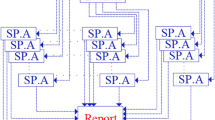Abstract
Predictions based on analytical performance models can be used on efficient scheduling policies in order to select adequate resources for an optimal execution in terms of throughput and response time. However, developing accurate analytical models of parallel applications is a hard issue. The TIA (Tools for Instrumenting and Analysis) modeling framework provides an easy to use modeling method for obtaining analytical models of MPI applications. This method is based on modeling selection techniques and, in particular, on Akaike’s information criterion (AIC). In this paper, first the AIC-based performance model of the HPL benchmark is obtained using the TIA modeling framework. Then the use of this model for assessing the runtime estimation on different backfilling policies is analyzed in the GridSim simulator. The behavior of these simulations is compared with the equivalent simulations based on the theoretical model of the HPL provided by its developers.
Similar content being viewed by others
References
Akaike H (1974) A new look at the statistical model identification. IEEE Trans Autom Control 19:716–723
Albín JL, Lorenzo JA, Cabaleiro JC, Pena TF, Rivera FF (2007) Simulation of parallel applications in GridSim. In: 1st Iberian grid infrastructure conference proceedings
Burnham KP, Anderson DR (2002) Model selection and multimodel inference. A practical information-theoretic approach. Springer, Berlin
Dongarra JJ, Luszczek P, Petitet A (2003) The LINPACK benchmark: past, present and future. Concurr Comput 15(9):803–820
Jann J, Pattnaik P, Franke H, Wang F, Skovira J, Riodan J (1997) Modeling of workload in MMPs. In: IPPS/SPDP’97/JSSPP’97: proceedings of the job scheduling strategies for parallel processing
Martínez DR, Blanco V, Boullón M, Cabaleiro JC, Pena TF (2007) Analytical performance models of parallel programs in clusters. In: Parallel computing: architectures, algorithms and applications. ParCo 2007
Martínez DR, Pena TF, Cabaleiro JC, Rivera FF, Blanco V (2010) Performance modeling of MPI applications using model selection. In: 18th Euromicro conference on parallel, distributed and networkbased processing
Sulistio A, Cibej U, Venugopal S, Robic B, Buyya R (2008) A toolkit for modelling and simulating data grids: an extension to GridSim. Concurr Comput 20(13):1591–1609
Tsafrir D, Etsion Y, Feitelson DG (2007) Backfilling using system-generated predictions rather than user runtime estimates. IEEE Trans Parallel Distrib Syst 18:789–803
Author information
Authors and Affiliations
Corresponding author
Rights and permissions
About this article
Cite this article
Martínez, D.R., Albín, J.L., Pena, T.F. et al. Using accurate AIC-based performance models to improve the scheduling of parallel applications. J Supercomput 58, 332–340 (2011). https://doi.org/10.1007/s11227-011-0589-1
Published:
Issue Date:
DOI: https://doi.org/10.1007/s11227-011-0589-1




